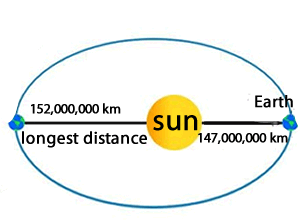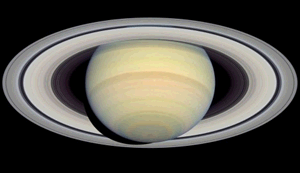Understanding our Solar System -Johannes Kepler

Johannes Kepler (1571-1630) worked with Brahe as an assistant.
Kepler, abandoned the notion of circular orbits of planets, that was proposed in earlier models, in favor of elliptical orbits. This greatly simplified the model of the Solar System. In Kepler's model planets orbited the Sun in Elliptical orbits.
Kepler came up with 3 rules to describe planetary motion around the Sun. These rules are listed below and some what simplified.
1. The orbits of the planets are ellipses, with the Sun at one focus. Early models with circular orbital motion could not account for observations that revealed non-uniform motion of planets. Elliptical orbits provided a perfect explanation for the observation made by early astronomers and eliminated the need for epicycles.
2. Motion of the planet around the Sun is not always uniform. The planet travels faster as it sweeps around the sun and slower when it is at its furthest point from the Sun.

3) The time it takes for a planet to orbit the Sun is related to its average distance from the Sun according to the formula below.
P2(Earth years) = D3 (AU)
Where AU is the Astronomical Unit
1 AU = 149,597,871 kilometers or
roughly the average distance Earth is from the Sun.

Astronomers at the time knew that the outer planets moved slower and took longer to circle the Sun than the inner planets which moved faster and took less time to orbit the Sun. Kepler had a suspicion that there existed a force holding the planets together. He formed the hypothesis that a physical force moved the planets, and that this force diminished with distance from the Sun. While planets closer to the Sun experienced a stronger force resulting in faster motion. This force was gravity but it was not until Newton that the theory of gravity took shape.
3) Saturn is 1,433,449,370 kilometres from the Sun. How many Earth years does Saturn take to orbit the Sun once?

Solution
6) View the NASA video on the right.
a) What is the Ecliptic Plane?
b) Kepler worked for Brahe and used only a small sample of the data collected by Brahe.
i) What was the current model of the Solar System when Kepler started to analyse data of the motion of Mars?
ii) Explain how this model worked?
c) How did Kepler differ with Brahe in their interpretation of the Solar System?
d) Kepler had difficulty getting the observed data of Mars to fit with the Copernican model of the Solar Sysytem.
i) Explain why?
ii) How did Kepler modify the Copernican model to fit with the observed Martian orbit?
e) Ellipses have special properties.
i) What is meant by the eccentricity of an ellipse?
ii) Define three properties of an ellipse.
f) Kepler's three laws describe the motion of
h) What does Kepler's second Law state?